Still tagging products manually? It requires over 83 hours for 1,000 items. Meanwhile, AI image tagging does the task in minutes. Discover how it works.
by YesPlz.AINovember 2025

Imagine this: It’s Monday morning, and your inbox is overflowing. Your team just received 1,000 new products that need to be added to your store. Each requires dozens of manual tags for color, size, style, and occasion. Your product manager estimates two weeks of full-time work before everything goes live. Meanwhile, your competitors are already launching similar products tomorrow, fully optimized for search and discovery.
Here’s the real problem: shoppers now use AI-powered search, chatbots, and LLMs to find what they want instantly. If your product data is messy, your site search is unreliable, and filters are clunky, you’re invisible to today’s digital shoppers.
If you’re still manually tagging products in 2025, you’re not just wasting time. You’re actively holding your business back. The good news? There is a smarter solution: AI image tagging. It is transforming how successful eCommerce stores manage their product catalogs.
Table of Contents:
Manual product tagging seems straightforward on the surface. You just look at a product, identify its characteristics, and add relevant tags. Pretty simple, right? But when you scale this process across hundreds or thousands of products, the cracks begin to show.
Recently, during a discovery call with a fashion retailer, their eCommerce manager asked a question that gets to the heart of the issue after seeing our demo of site search and filtering enhanced with enriched product data:
“Do we need to tag products manually, or is tagging done automatically based on product images?”
This question highlights a fundamental concern shared by almost every product manager—the challenge of manual tagging and the hope for a smarter, automated solution.
Let’s do some quick math. If it takes just 5 minutes to tag a single product with all relevant attributes, that’s 12 products per hour. For a modest catalog of 1,000 products, you’re looking at over 83 hours of work. This is equivalent to more than two full work weeks for one person. And that’s assuming no breaks, no mistakes, and perfect efficiency.
Those 83 hours aren’t just expensive. They’re also preventing your team from doing work that actually grows your business. Every hour spent on manual data entry is an hour not spent on other important tasks. Let’s say, marketing strategy, customer service, or product development. Your most talented team members become data entry clerks.
Even with the best training and detailed guidelines, manual tagging suffers from a fundamental flaw: human subjectivity. One team member might tag a dress as “midi length.” The other calls the same “knee-length.” Someone having a rushed day might miss important attributes entirely. New employees might interpret your tagging guidelines differently from veterans.
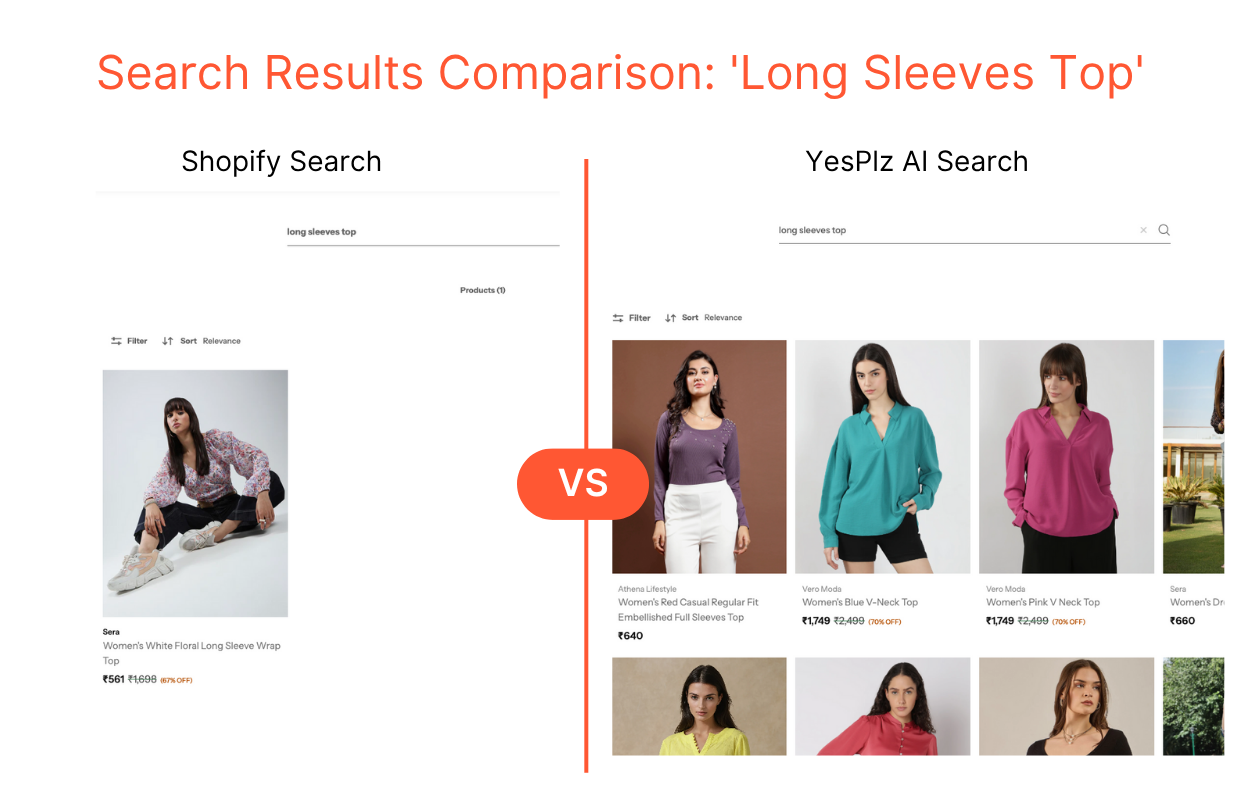 These inconsistencies create real problems for your shoppers. When they search for or filter by a specific attribute, they might miss perfect matches. This is because of tagging variations or because someone forgot to tag that attribute. Each missed connection is potentially lost revenue.
These inconsistencies create real problems for your shoppers. When they search for or filter by a specific attribute, they might miss perfect matches. This is because of tagging variations or because someone forgot to tag that attribute. Each missed connection is potentially lost revenue.
As your business grows and your catalog expands, the time required for manual product tagging grows proportionally. Many product managers find themselves in an impossible position. They want to expand their product range, but can’t keep up with the tagging workload.
New product launches get delayed. Seasonal collections miss their optimal launch windows. The very growth you’ve worked so hard to achieve becomes constrained by a data entry bottleneck. The more success you have, the worse your manual tagging problem becomes, not better.
Besides, tagging isn’t a one-time task. Products need re-tagging when:
Fashion terminology evolves.
Your filtering options expand.
You discover tags that aren’t performing well in search.
Product trends shift; thus, it requires new categories.
But who has time to go back through thousands of existing products to update tags? The outcome is that the older inventory languishes with incomplete or outdated data. Your long-tail products, which could be profitable, become virtually invisible to shoppers.
Manual tagging isn't just slow and expensive. It creates three fundamental problems that directly impact your revenue and competitive position.
Inconsistent or missing product tags mean your site search fails to surface the right items. When shoppers can’t find what they want quickly, it results in lost sales and lower customer satisfaction.
Filtering should help shoppers narrow down options quickly. However, manual tagging often results in limited, incomplete attributes, failing to provide the detailed filters essential for fashion shopping. Manually tagging detailed style attributes is time-consuming and costly. As a result, filters remain basic and do little to help shoppers find their preferred styles quickly.
Here's the most recent concern we're hearing from eCommerce managers in every discovery call: their products are becoming invisible in ChatGPT, Perplexity, and other LLM-powered search platforms. This isn't theoretical. It's happening right now as AI search engines are rapidly changing how people discover and shop for products.
The technology behind AI image tagging might sound complex. But its concept is surprisingly simple. Instead of relying on humans to manually tag, the AI image recognition technology analyzes product images directly. It then automatically extracts relevant information.
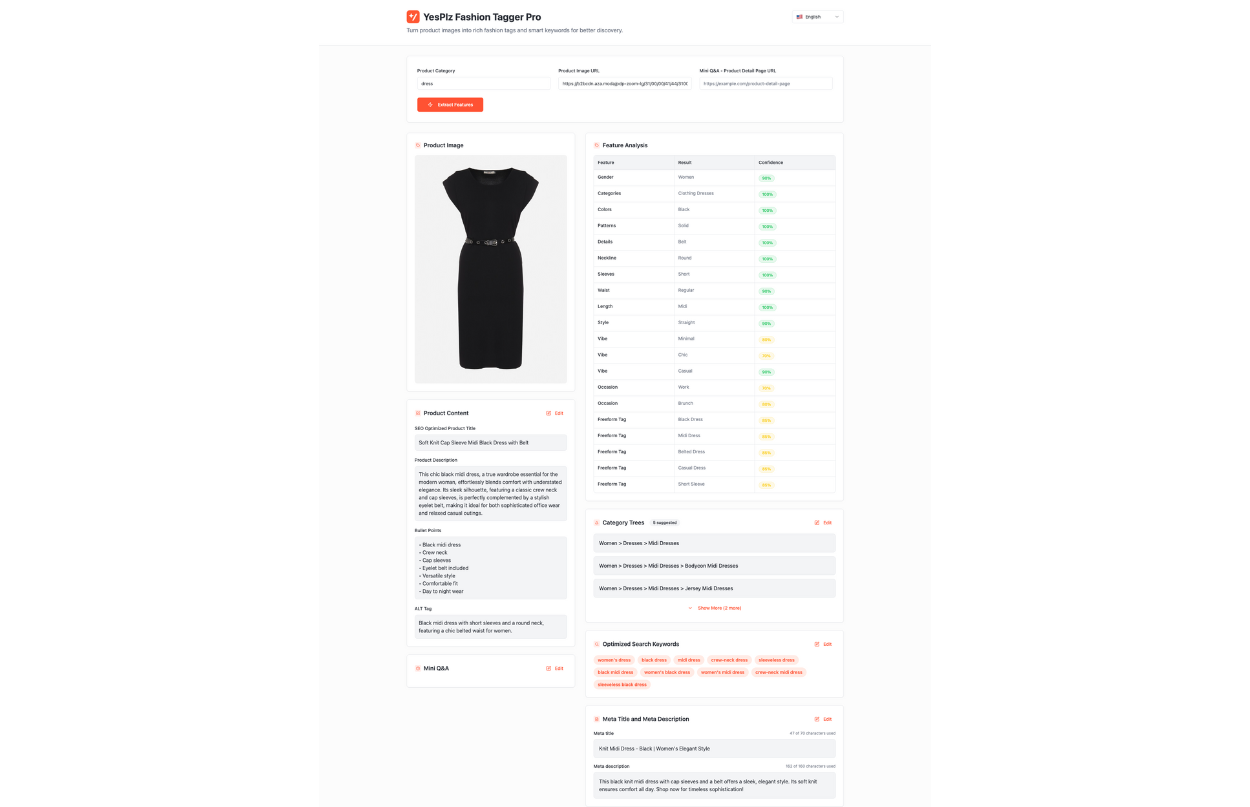 When we explained this to the eCommerce manager during our call, she wanted to make sure she understood correctly:
When we explained this to the eCommerce manager during our call, she wanted to make sure she understood correctly:
“It screens the images, and then based on that, the algorithm creates filters?”
Our answer: “Yes, exactly.”
AI product tagging uses computer vision. This is the same technology that helps your phone recognize your face. However, instead of being trained to recognize faces, this image recognition for eCommerce is trained on millions of product images across various categories. It analyzes the visual properties of a product in the same way a human would, but with perfect consistency and at incredible speed.
For example, it doesn’t just see a blouse. It identifies specific visual attributes, such as:
Colors: Black, green
Patterns: Floral
Details: Ruffle
Necklines: Halter
Sleeves: Sleeveless
Waists: Regular
Length: Regular
Vibes: Romantic, feminine
etc.
AI extracts all eCommerce product attributes that shoppers might search for or filter by.
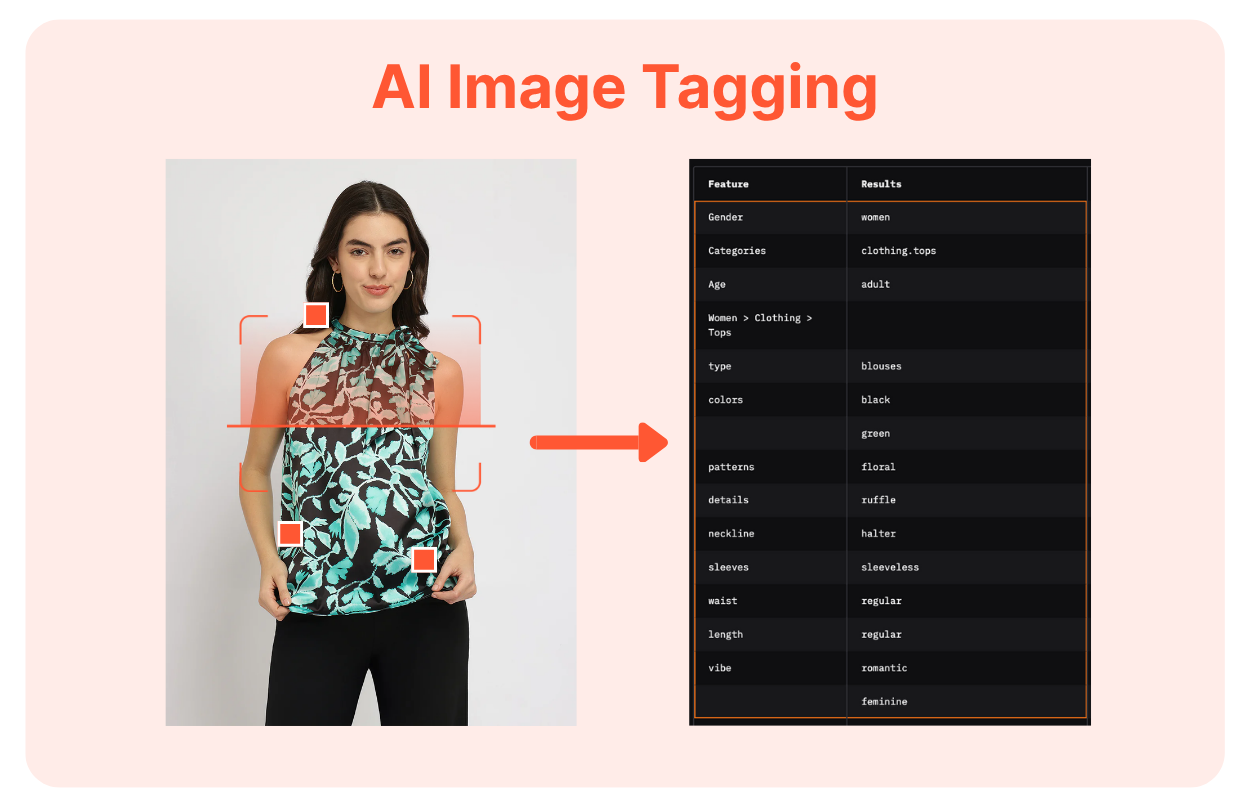 The Automatic Process of AI Image Tagging
The Automatic Process of AI Image TaggingHere’s how simple the workflow becomes:
You upload product images to your eCommerce platform.
AI scans each image, identifies attributes, and automatically generates relevant tags.
The keyword here is “automatic.” As our CEO, Jiwon Hong, explained to the eCommerce manager:
“From product images, our AI automatically extracts the key product information. And then, we update it automatically to your product field.”
What makes AI image tagging especially powerful is how it enhances the entire shopping experience. The automatically generated tags actively power both search functionality and filtering options.
Consider this scenario: A shopper searches for “flowy summer dress.” Your product might be titled “Floral, Romantic Long Dress” with a description that doesn’t contain the word “flowy.” With manual tagging, it is unlikely that you will add a “flowy” tag. As a result, when shoppers search for or filter by this attribute, this product wouldn’t appear in search results.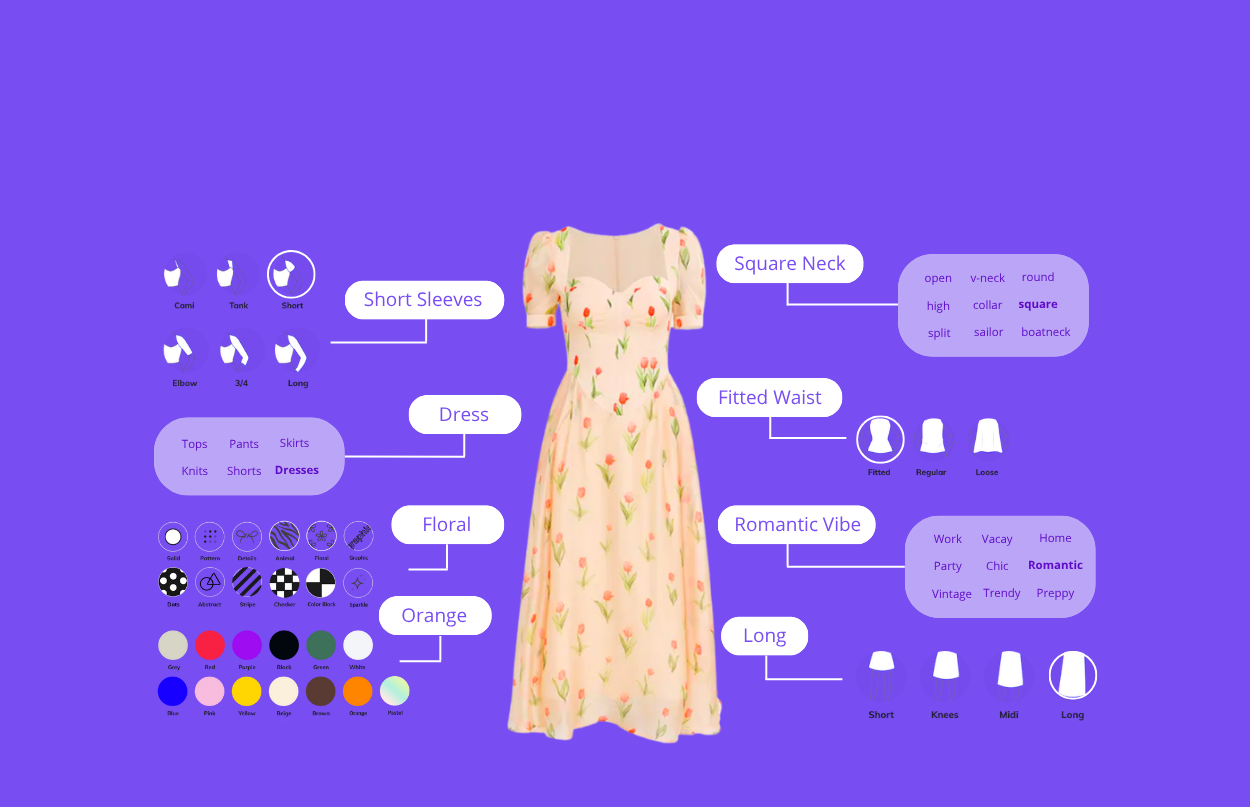 But AI analyzes the visual drape and fit of the dress in the image. It recognizes the loose, flowing silhouette and automatically tags it accordingly. AI ensures that even if a product title and description don’t match a search query, relevant results are still returned due to the AI-generated tags.
But AI analyzes the visual drape and fit of the dress in the image. It recognizes the loose, flowing silhouette and automatically tags it accordingly. AI ensures that even if a product title and description don’t match a search query, relevant results are still returned due to the AI-generated tags.
This visual understanding creates a richer, more comprehensive product data layer. The result? Your entire catalog is more discoverable through search and filters.
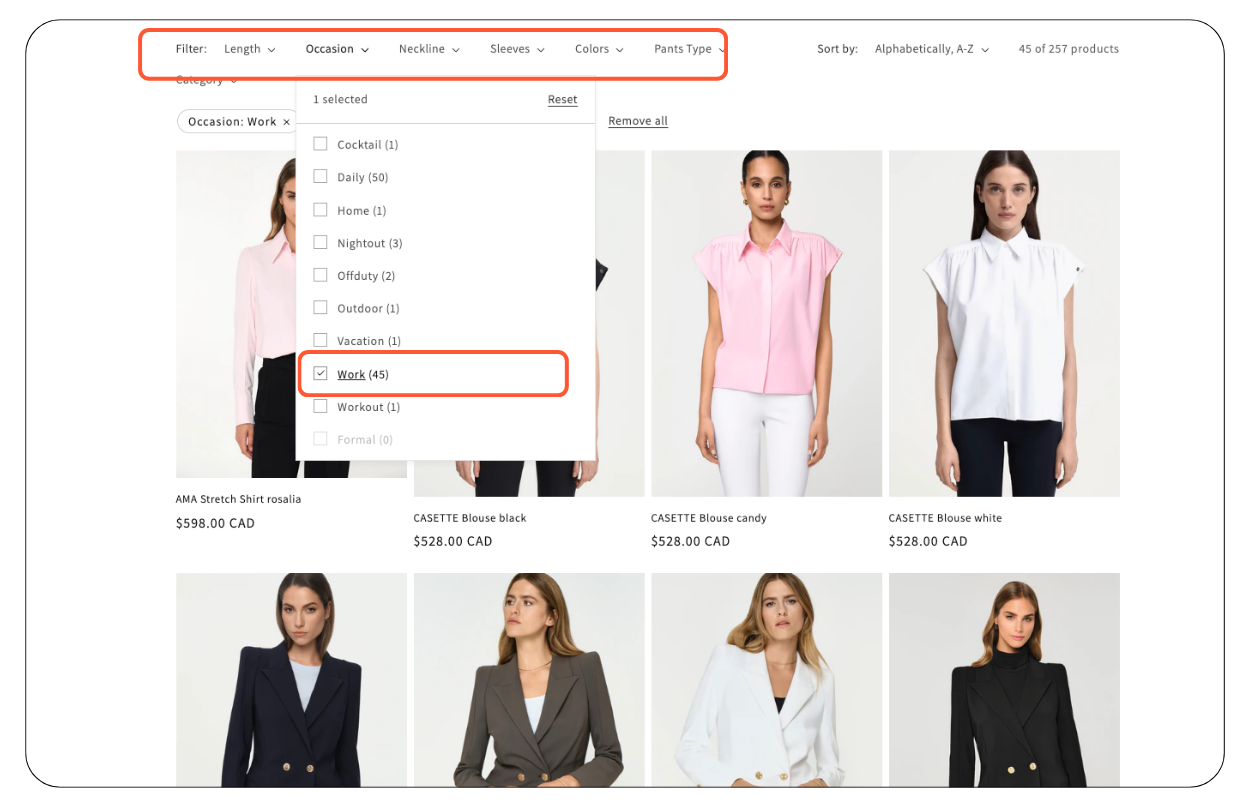 Manual vs AI Tagging: The Direct Comparison
Manual vs AI Tagging: The Direct ComparisonLet’s lay out exactly what changes when you move from manual to AI-based product tagging through the table below:
| Aspect | Manual Tagging | AI Image Tagging |
| Who tags? | Humans tag each product image. | AI scans and tags the entire inventory. |
| Speed | Slow, labor-intensive. | Fast, scalable. |
| Consistency | Varies by person, mood, and training level. | Achieves uniform, reliable standards every time. |
| Scalability | Becomes exponentially harder with catalog expansion. | Handles 100 or 100,000 products equally well. |
| Maintenance | Requires ongoing manual effort to update. | Automatically updates as products change or trends evolve. |
| Accuracy | Prone to typos, missed attributes, and human subjectivity. | Consistent attribute detection based on objective visual data. |
| Cost | High labor costs that scale with catalog size. | One-time setup, minimal ongoing costs. |
What actually changes when you switch from manual to automated product tagging? A lot more than you might expect. The benefits start showing up almost instantly, and continue to grow over time.
The first change you’ll experience is time liberation. Product launches that previously took weeks now happen in days or even hours. That freed-up time gets directed toward actually strategic work.
This was the biggest relief for the eCommerce manager we spoke with. Her concern about whether she and her team would need to tag products was completely dispelled when she learned that the system is fully automatic. Her team does not have to perform any manual work. No delays. No bottlenecks.
From your shopper’s perspective, the change is dramatic. Search results become more relevant. Filtering becomes truly useful. Shoppers can narrow down by multiple attributes and get accurate results.
Especially, AI image tagging powers visual filters. For instance, shoppers can select a body part on a virtual mannequin filter. AI then retrieves the relevant results immediately. The shopping journey, therefore, becomes faster and more satisfying. Instead of scrolling endlessly, shoppers can find desired items in seconds.
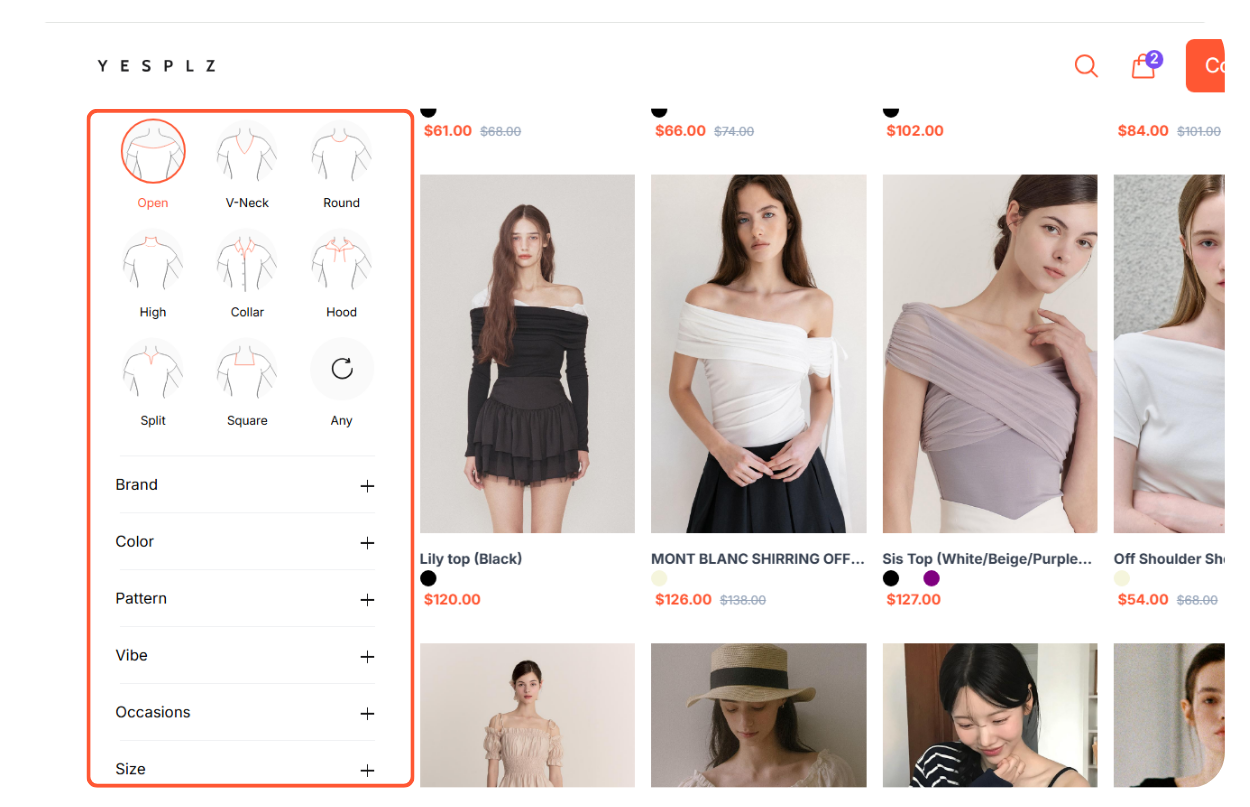 Comprehensive and consistent product attribute tagging happens across the entire catalog. As a result, product discoverability improves immediately. This efficiency directly translates to higher conversion rates and fewer abandoned browsing sessions.
Comprehensive and consistent product attribute tagging happens across the entire catalog. As a result, product discoverability improves immediately. This efficiency directly translates to higher conversion rates and fewer abandoned browsing sessions.
Your competitors struggle with manual tagging bottlenecks? You’re launching new products weekly. They miss seasonal opportunities (because product data isn’t ready)? You’re capturing early-season demand. They’re limited to basic product descriptions? You offer rich, detailed attribute-based AI-powered product search and automated product filtering, creating a premium shopping experience.
This advantage compounds over time. You can expand into new product categories faster. You can test new inventory without the data entry barrier. You can offer more SKU variations because the tagging burden is zero. Growth becomes easier, not harder.
AI image tagging creates a foundation for advanced eCommerce features. Visual filters rely on the same visual attribute data. Recommendations become more personalized with comprehensive product tagging. Individual styling advice needs detailed attributes to make relevant matches.
Beyond improving your own site's search and filtering, AI image tagging solves a problem that's only going to get bigger: visibility in AI-powered search and shopping assistants.
You’re not just solving today’s tagging problem; you’re building the data infrastructure for tomorrow’s innovation. As AI continues to evolve and new shopping features emerge, you’re positioned to adopt them quickly. This is because your product data is already structured, comprehensive, and machine-readable.
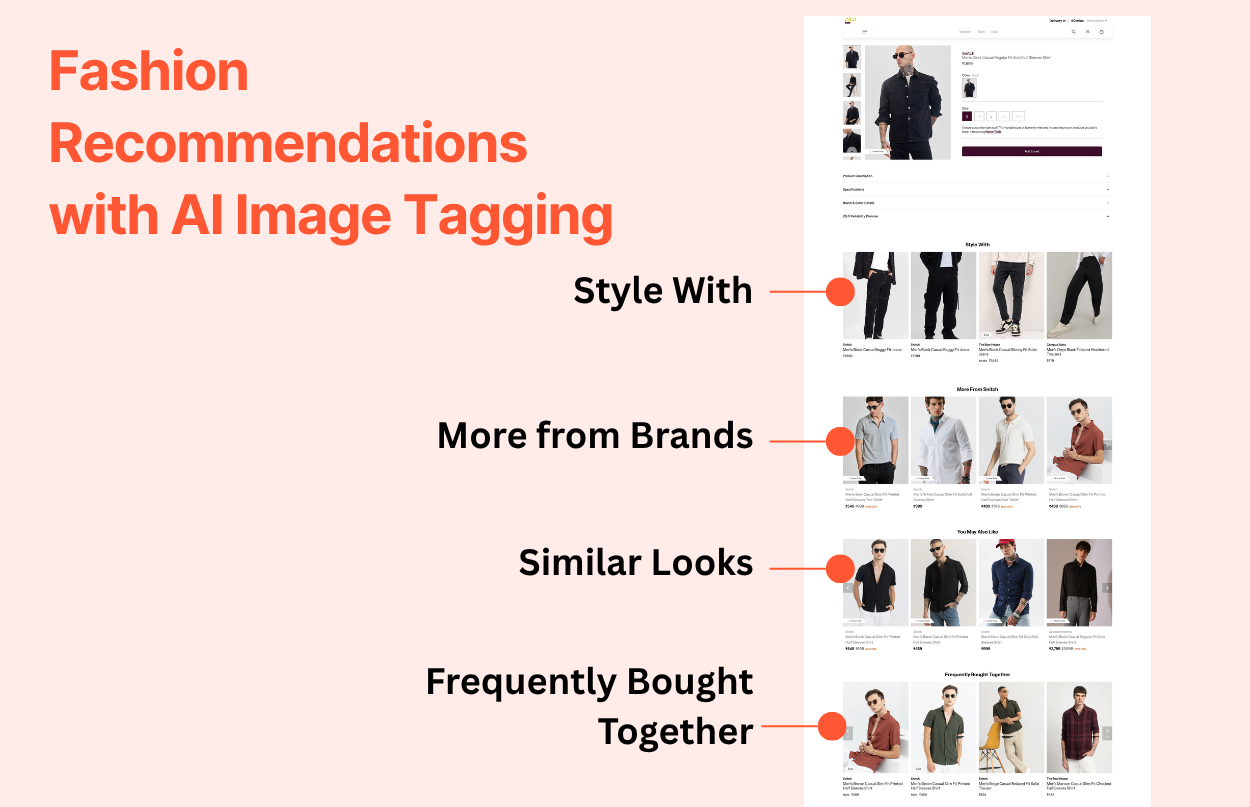 Addressing Common Concerns About AI Image Tagging
Addressing Common Concerns About AI Image TaggingDespite the clear advantages, many online store owners still hesitate about adopting AI for product discovery upgrade. In this section, we will directly address the most common concerns raised during our conversations with different eCommerce managers.
AI tagging delivers value for most eCommerce operations. But it’s especially transformative in the situations listed below.
Or, if you’re planning to grow your catalog significantly. Under 100 products, manual tagging might still be manageable. Above that threshold, automation becomes essential.
Every day your new products aren’t live is lost revenue. If you’ve ever missed a seasonal opportunity or watched competitors launch similar products first, that’s a clear signal.
Did you see search queries that didn’t return relevant results? Or, did your shoppers complain about the accuracy of filtering options? These are red flags that your tagging data has quality issues.
Auto product attribute tagging provides the solid foundation to fix them. You can invest in better search algorithms, but they can only work with the current data you have.
In this case, product tagging automation is the only path. Hiring more people to do manual tagging isn’t a real solution to the problem. Keep hiring will not stop the workload from growing. Soon, you’d need an entire team or department to handle repetitive tagging tasks.
Manual tagging doesn’t scale, so adding more people won’t fix the underlying inefficiency. With automated product tagging, you can expand your catalog without adding a single person to your tagging team.
YesPlz tagging isn’t a semi-automated tool that suggests tags for you to approve. It’s truly hands-off automation. As Jiwon clarified with the eCommerce manager in the discovery call, "If it's not automatic, we would not be having this conversation."
That’s the fundamental difference between true automated tagging and manual-assist tools that still require human oversight. There’s no review queue waiting for human approval. No bottleneck where you need to verify the tags. No delay between uploading a product and having it fully tagged and searchable.
This concern stems from a misunderstanding of how AI image tagging works. You’re not handing over your product data to an uncontrollable algorithm. You maintain complete oversight and access to all product information.
Although AI tagging enhances your data, it doesn’t replace your judgment. If you ever need to delete or add specific tags, you can do so. The difference is that you’re making occasional refinements rather than doing comprehensive manual data entry for every single product.
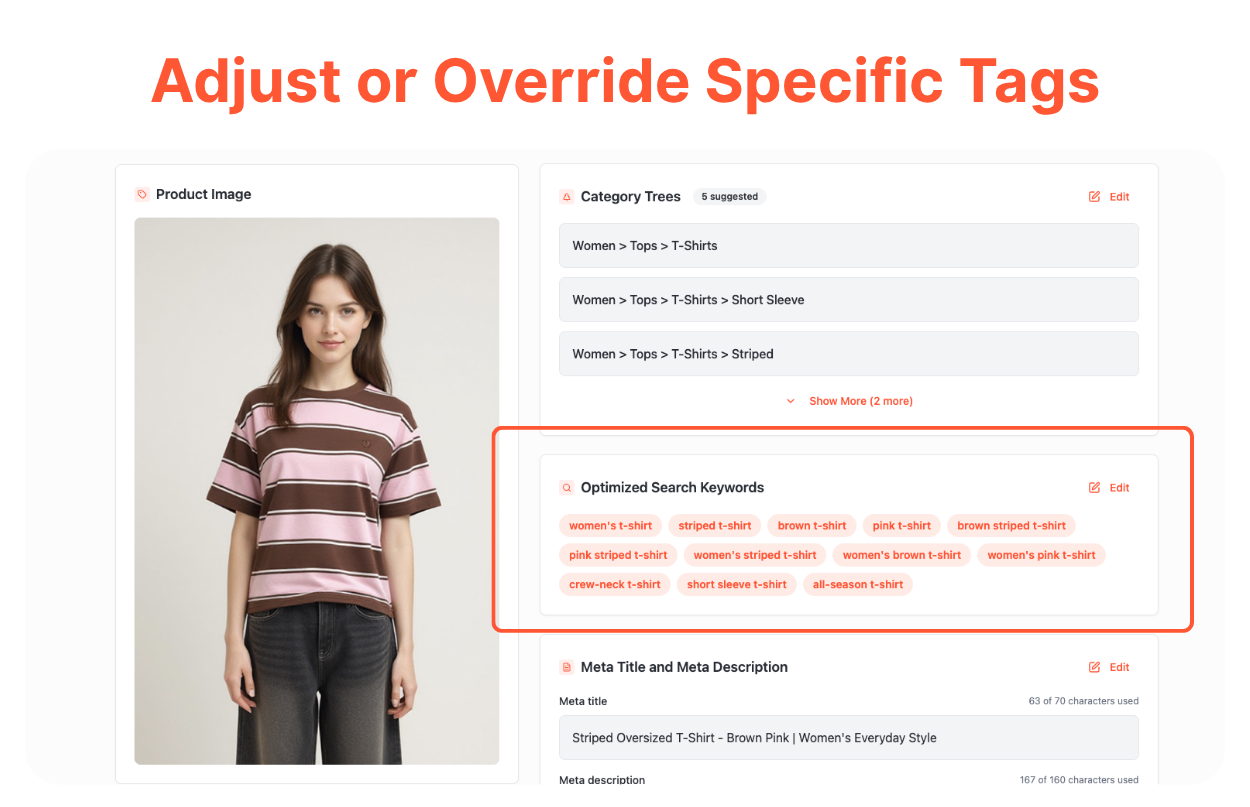 Think of it like spell-check in your word processor. It automatically catches and corrects most errors, dramatically reducing your workload. But you’re still in control. You can adjust any suggestion, and you remain the final authority on your content.
Think of it like spell-check in your word processor. It automatically catches and corrects most errors, dramatically reducing your workload. But you’re still in control. You can adjust any suggestion, and you remain the final authority on your content.
This is perhaps the most frequent worry, especially for stores with unique or specialized inventory. The concern is understandable. If you sell niche products, will the product attribute tagging system recognize your specific characteristics?
As mentioned earlier, AI is trained on millions of product images across diverse categories. They’ve seen everything, from haute couture to athletic wear, from vintage styles to cutting-edge fashion. They recognize industry-specific terminology and can identify subtle distinctions that matter to your shoppers.
More importantly, AI is continuously learning and improving. Every image it analyzes makes it better at recognizing variations and edge cases. AI that tags your product today is more sophisticated than the version from six months ago. And it will be even better six months from now.
Every catalog has outliers. The vintage piece that doesn’t fit normal categories. The limited edition item has unusual features. Or, the experimental design that defies conventional tagging.
Surprisingly, AI often handles these edge cases better than humans. Why? Rather than trying to fit items into preconceived mental categories, it analyzes visual properties objectively. It identifies what it sees in the image, regardless of whether that combination of attributes is typical or weird.
A human tagger might struggle with how to categorize an avant-garde piece that blends multiple styles. AI identifies all relevant visual attributes it detects and tags accordingly. Let’s say, unconventional sleeve design, asymmetric hem, mixed patterns, etc. The result is often more accurate, comprehensive, and objective than manual tagging.
Let’s talk ROI. If you have someone spending 40 hours per week on product tagging, that’s 2,080 hours per year. At a modest $10/hour fully loaded cost, that’s $20,800 annually, just in direct labor costs for tagging. Whereas, AI product tagging ranges from $0.05 to $0.20 per product for 10-15 tags. Thousands of products can be tagged within 5-10 minutes.
The real cost of manual tagging is higher. What’s the opportunity cost of those 2,080 hours? What could your team accomplish with that time if they weren’t doing data entry? What revenue opportunities are you missing because products aren’t launching fast enough? What’s the cost of poor search performance and lower conversion rates due to inconsistent tagging?
When you account for these hidden costs, the ROI of automated tagging becomes significant. Most businesses see payback periods measured in weeks or months, not years. The bigger risk isn’t the cost of switching. It’s the competitive disadvantage of staying with a manual process while your competitors automate.
The barrier to entry for AI image tagging has dropped dramatically in recent years. You don’t need a massive IT overhaul or a six-month implementation project. Most AI tagging solutions integrate with popular eCommerce platforms, whether it’s Shopify, Magento, or custom websites, through standard APIs or plugins.
The typical implementation timeline is days to weeks, not months. You’ll see results almost immediately, often as soon as your first batch of products is processed. The technical requirements are minimal. The complexity happens on the AI tagging provider’s side, not yours.
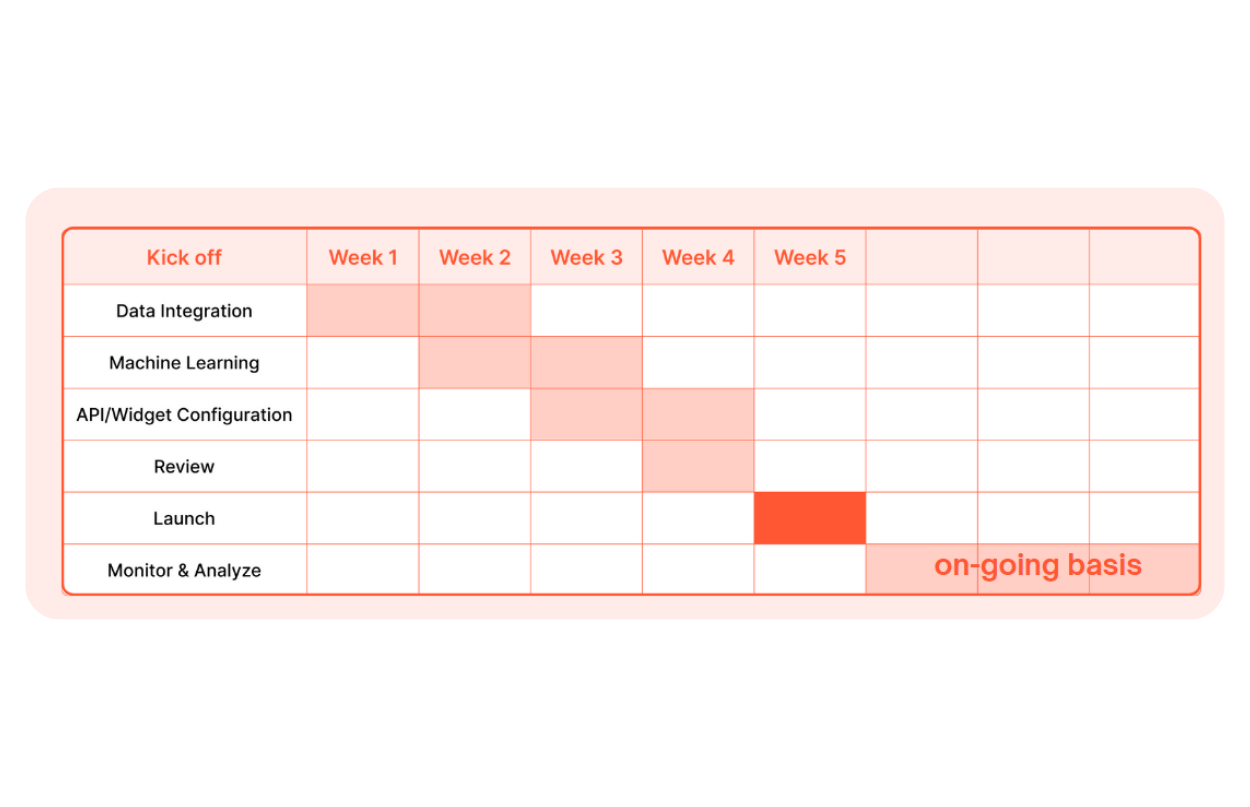 Conclusions
ConclusionsThe technology is proven. The ROI is clear. The implementations are straightforward. What's holding you back from implementing product data automation for your eCommerce store? Don’t let manual tagging slow you down. Schedule your demo with us and see AI image tagging in action.

Written by YesPlz.AI
We build the next gen visual search & recommendation for online fashion retailers
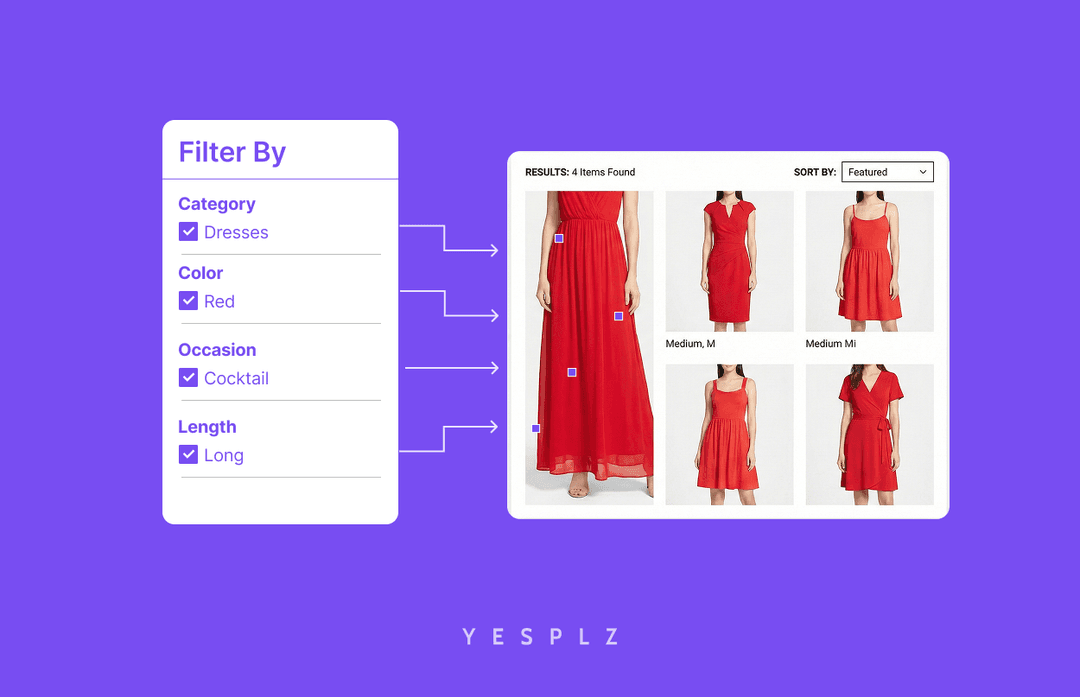
Stop losing sales to poor product filtering. Discover how AI simplifies creating Shopify filters, saving you 25-50 hours per 100 products.
by YesPlz.AI

Automate Shopify product pages and cut 50–100 hours of manual work. AI generates product titles, descriptions, and metadata instantly from product images.
by YesPlz.AI